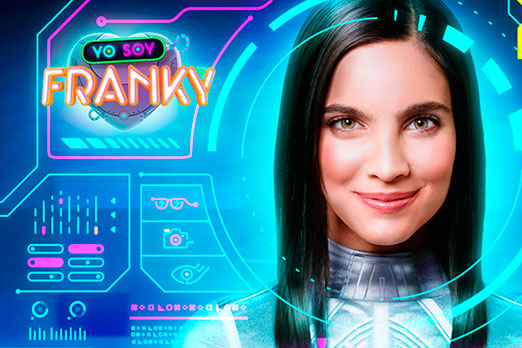Nick OKs Global ‘Yo Soy Franky’ Adaptation

When the time came for Viacom Kids and Family Group to decide on the first series to produce from its new Miami multiplatform production hub, all eyes turned south to Bogotá, Colombia.
Bogota is where the second season of Nickelodeon’s Latin American hit Yo Soy Franky is set to begin, with promos to be shot this week by a joint U.S.-Colombian team. An English-language adaptation of the telenovela, I Am Frankie, will be the first show to originate from the new Viacom International Studios hub, located on the edge of Miami’s hip Wynwood arts district.
Created by Marcela Citterio, Franky was green-lighted last July and debuted across the region in September. It's being adapted for the U.S. by Miami-based Catharina Ledeboer, head writer for such Nickelodeon Latin America shows as La Cocina de Talia (“Talia In the Kitchen”).
The teen telenovela is centered around “Franky,” an experimental android and supercomputer created to look like a 15-year-old girl. Franky attends school and only her “family members” at home are aware that she is a robot. She learns about family life, making friends and even the challenges of having a boyfriend.
Now, Franky will become Frankie. I Am Frankie, a global, English-language adaptation of the show, will be cast this spring and shot this summer. Nickelodeon has ordered 20 episodes for distribution in 160 countries and territories where its programming airs. No premiere date has been set.
Yo Soy Franky stuck to the traditional telenovela format, with 60 hour-long episodes in its just-concluded first season.
Nickelodeon decided to go with an English-language version of Yo Soy Frankie for two reasons, VIMN Americas executive vice president and chief operating officer Juan “JC” Acosta told Hispanic Television Update in an exclusive interview.
The smarter way to stay on top of the multichannel video marketplace. Sign up below.
“It is not only because of its success and high ratings in Latin America, but also due to its relatable and universal story lines that appeal to global audiences,” Acosta said.
After just three months on the air, the total viewership for Franky totaled 4.5 million viewers; it is No. 1 in its key teen target demos in Colombia, Argentina, and Mexico.
The show’s official blog has also generated some 1.5 million visits, mostly from Colombia and Mexico. That’s half of all Web traffic to MundoNick.com, Nickelodeon’s Latina America portal, and its Nick app for smartphones.
Yo Soy Franky is produced in Colombia by Televideo with on-site participation from VIMN Americas production staff. It stars 23-year-old Venezuelan actress Maria Gabriela de Faria, best known for her role as “Isa” in the Nickelodeon Latin America series Isa TKM.
While “I Am Frankie” was the first choice for shows to be produced in Miami, it’s not the first time a program from Latin America has been adapted for Nickelodeon’s U.S. audience. For example, Every Witch Way, an adaptation of Nickelodeon Latin America’s Grachi, aired for four seasons on Nick from January 2014 through July 2015.
The decision is a vote of confidence in Latin America-originated content as Hispanics comprise a larger share of the U.S. teen-age audience, Acosta said.
“It speaks to the quality of the content coming out of Latin America, and how it can have international success,” he said. “The key is to have strong characters with universal storylines that are able to translate into successful formats that can be easily adapted to any market.”
What does the production of I Am Frankie say about the distribution of programs from Latin America in the U.S. and across the globe?
“There is great content coming out of Latin America, across all genres,” Acosta notes. “This presents a huge opportunity for distribution and localization to international markets. It’s great to see the region expanding their footprint and reaching global audiences.”
Interestingly, Nickelodeon has eschewed a 24/7 Spanish-language outlet for U.S. audiences.
Nick’s appeal to Latino young adults and children dates back more than 15 years, with the 2000 debut of preschool cartoon Dora the Explorer and spinoff Go, Diego, Go!, which aired from 2005-2011. Both programs had been a part of Univision’s Saturday-morning Planeta U lineup, following two seasons on Telemundo from 2006-2008.
Given population trends, perhaps Nickelodeon’s best play at attracting Latino youth is with English-language programming. According to Pew Research Center’s 2013 American Community Survey, 14.2% of the entire Hispanic male population is 14 or under. Some 13.6% of all Hispanic females are 14 or under.
Furthermore, kids age 14 and under represent 21% of all U.S.-born Hispanics, a telltale sign that births, rather than immigration, are pacing Latino population growth. Just 2% of foreign-born U.S. Hispanics are 14 or younger.
Should a Latina be cast as "Frankie," Nickelodeon would offer the best demonstration on how “total market” strategies currently seen in the Hispanic marketing and advertising arena have been further extended through programming decisions.
Cyma Zarghami, president of Viacom's Kids and Family Group, offered no hints about casting, though.
“I Am Frankie is a fresh and different format and has an incredibly talented team behind it,” she said. “Miami has been a content hub for Nickelodeon for some time, and our talent continues to innovate their approach to both content and platforms.”
